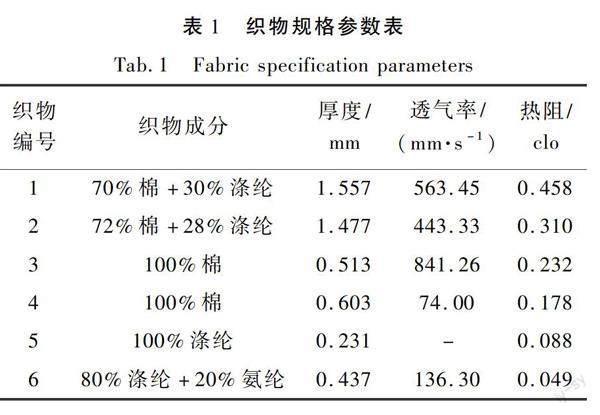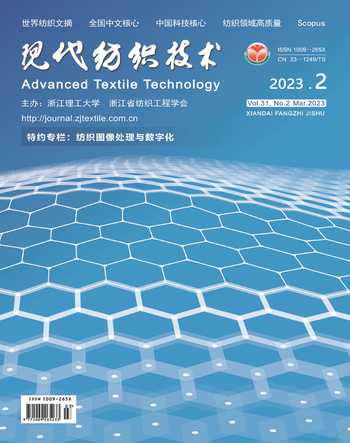加热型织物系统的热传递性能
张雪原 吕凯敏 戴宏钦 谢丹 夏媛媛



摘要:为优化电加热服的设计,建立皮肤、衣下空气层与加热型织物的组合体,探索其对加热型织物系统传热性能的具体影响。选用6种不同的织物,并通过在测试板与织物之间放置不同厚度的分隔板来模拟衣下空气层,分析加热装置关闭与打开时加热型织物系统的热阻和加热装置提供给测试板的加热功率的变化,评价织物系统的热量传递。结果表明:不论加热装置是否开启,加热型织物系统的热阻都随空气层厚度的增大而增加;加热装置打开时织物性能对织物系统热阻的影响增强;加热装置放置位置越靠近皮肤,加热效率越高。
关键词:电加热服装;热阻;空气层厚度;热流量
中图分类号:TS941
文献标志码:A
文章编号:1009-265X(2023)02-0146-06
低温对人们的工作状态和身体健康都有显著影响,易造成冻伤、四肢灵活度下降等问题,因此需穿着防寒服维持人体热舒适,其中轻便、恒温可控的电加热服被广泛关注[1-2]。但目前市面上的电加热服缺乏严谨的设计,可能导致皮肤烫伤或保暖不足、造成电池能源的浪费,使得电加热服难以提供长时间的有效供暖[3]。
目前对于无内部加热源的织物传热性能已有一定的研究。Dan等[4-5]建立了单层织物系统热传递的数学模型,利用模型分析得出织物厚度与衣下空气层厚度均对织物系统热传递性能有显著影响,衣下空气层自然对流的发生会导致织物系统热阻的减小。张昭华等[6]利用出汗热平板仪测试得出,随着衣下空气层厚度的增大,织物系统热阻增加;与衣下空气层相比,织物的厚度对织物系统热阻影响较小。张洁等[7]基于牛顿插值公式拟合纱线方程建立了织物模型,模拟分析三原组织织物结构对热传递性能的影响。由此,在无内部加热源情况下,影响织物系统热传递性能的主要因素有织物性能和衣下空气层厚度。而对于有内部加热源的织物传热性能研究较少。Park等[8]通过暖体假人实验得出,在人体皮肤旁提供电加热对于减少人体热损失是最有效的,但该研究缺少空气层厚度对服装传热性能影响的定量分析。范敏等[9]通过分析模型得出电加热服越靠近人体皮肤,起到的保暖效果越好。陈杨等[10]利用有限元模型分析得出随着织物热阻或空气层厚度增加,沿织物平面和厚度方向的热量传递都有增大。通过文献梳理发现,目前对于有内部加热源的织物传热性能缺乏系统性研究与定量分析。
其他学者已系统地研究织物性能与衣下空气层厚度对织物系统传热性能的影响规律,而本文重点探究在引入内部加热源情况下,不同织物性能以及空气层厚度对织物系统热传递性能的影响,通过建立加热型织物系统,利用出汗热平板仪模拟人体-电加热服-环境之间的稳态传热,定量分析加热装置关闭与打开时加热型织物系统热阻和加热装置提供给测试板的加热功率的变化特征,探究织物性能和空气层厚度对加热型织物系统热传递的影响规律。
1实验
1.1实验织物
以基层织物、空气层、粘附有加热装置的织物建立加热型织物系统,系统截面图如图1所示。选取6种低温环境下防寒服常用织物,其织物具有不同的厚度与透气率,以探究织物不同性能对加热型织物系统隔热性能的影响,织物基本性能如表1所示。首先将织物裁剪成50 cm×50 cm的样品,每块样品各取3块试样,把裁剪好的样片熨平。将六种材料在标准大气条件下平衡24 h后进行试验。实验所用加热装置为市面上所购的碳纳米管加热薄膜,大小为30 cm×18 cm,加热面积为530 cm2。进行实验前,将加热薄膜利用医用胶带固定在织物反面中央。
1.2实验装置
1.2.1ISGHP热阻湿阻检测仪
测试采用美国西北测试科技公司的ISGHP热阻湿阻检测仪(出汗平板仪)。该仪器由热护环、热护底板、热量测定装置、温度控制器、定量供水装置和测试板构成。在环境箱内部可以模拟不同的外界环境温湿度及环境风速[11]。
1.2.2衣下间隔板
为模拟不同厚度的衣下空气层,自制衣下分隔板,如图2所示。为了防止织物由于自重而下垂,在分隔板上利用尼龍纱线制成网格状,保证衣下空气层厚度的准确,分隔板的高度分别为0、3、6、9、12 mm和15 mm。
1.3实验过程
本文实验利用出汗热平板仪模拟人体皮肤环境,按照GB/T 11048—2018《纺织品 生理舒适性 稳态条件下热阻和湿阻的测定(蒸发热板法)》标准进行测试[12]。气候舱内的温度控制在(20±0.5)℃,相对湿度(65±4)%,风速为(1±0.1)m/s,测试板的温度控制在(35±0.2)℃。紧贴测试板之上放置针织棉布作为基布模拟人体贴身穿着服装,平铺后在上方放置分隔板,再将粘附有加热薄膜的织物平铺在分隔板上。对6种加热型织物系统分别进行加热装置关闭与打开(加热装置设定温度为48℃)两种模式下的测试,每种织物在两种加热模式下均进行3次实验,实验数据为3次实验的平均值。
1.4评价指标
1.4.1热阻
热阻计算如式(1)所示:
Rct=(Tm-Ta)A/0.155H-Rct0(1)
式中:Rct是织物有效热阻,clo;Tm是测试板温度,℃;Ta是环境温度,℃;H是提供给测试板的加热功率,W;A是测试板的面积,m2;Rct0是为热阻Rct的测定确定的仪器常数,clo。
1.4.2加热装置提供给测试板的加热功率
加热型织物系统加热装置提供给测试板的加热功率计算如式(2)所示:
Q=Q0-Q1(2)
式中:Q是加热型织物系统加热装置提供给测试板的加热功率,W;Q0是加热型织物系统加热装置关闭时仪器提供给测试板的加热功率,W;Q1是加热型织物系统加热装置打开时仪器提供给测试板的加热功率,W。
2结果与分析
2.1未加热时系统热传递分析
当衣下空气层厚度从0 mm增加到15 mm时,加热装置关闭时各织物系统热阻变化如图3所示。
从图3可以看出,随着空气层厚度的增大,6种加热型织物系统的热阻显著增加,这是由于衣下空气层保留的静止空气具有较好的隔热效果。织物系统热阻增长速度随着空气层厚度的增加而下降,这与其他学者研究结果一致。而在本文研究中,从0 mm增加到15 mm的空气层厚度对织物系统热阻的影响并未出现拐点。以6#织物系统为例,当空气层厚度从0 mm增加到3 mm,热阻增长幅度为131%,但从12 mm增加到15 mm时,增长幅度仅为4.7%,说明15 mm已接近该织物系统热阻出现极大值时对应的最佳空气层厚度。采用回归分析法建立织物系统热阻与衣下空气层厚度之间的关系,结果如图4所示,织物系统热阻与衣下空气层厚度之间有显著的线性相关性,其相关系数R2=0.86,回归方程如式(3)所示:
y=0.05x+0.38(3)
式中:y为织物系统热阻,clo;x(x≤15)为衣下空气层厚度,mm。
衣下空气层厚度为0 mm时,6种织物系统热阻值标准差是0.121,而在空气层厚度为15 mm时,标准差减少到0.074,反映了随着空气层厚度增加,加热型织物系统的织物性能对热阻的影响减弱。此外,随着空气层厚度增大,不同透气性能的织物系统热阻增长幅度不同。以成分相同、厚度相近的3#和4#织物系统为例,在空气层厚度从12 mm增加到15 mm时,透气率较大的3#织物系统热阻增长幅度为3.4%,而透气率较小的4#织物系统热阻增长幅度为8.8%,说明透气性能差的织物系统最佳空气层厚度更大。从以上分析可看出,衣下空气层厚度对织物系统热阻的影响大于织物性能的影响,在实际穿着无加热源服装时,适当增大服装宽松量对服装整体保暖效果有重要作用。
2.2加热时系统热传递分析
当衣下空气层厚度从0 mm增加到15 mm时,加热型织物系统加热装置关闭与打开时的热阻变化如图5所示。
当加热装置打开后,6种加热型织物系统热阻值均比不加热时大,且随着空气层厚度增大有不同程度的增加。这说明在设计电加热服时,相对较宽松的服装宽松量有利于服装保温。衣下空气层厚度为0 mm时,6种织物系统热阻标准差是0.476,而在空气层厚度为15 mm时,标准差增加到0.678,说明随着空气层厚度的增加,织物性能对加热型织物系统热阻的影响增大。
当空气层厚度为0 mm,6种加热型织物系统加热后比加热前热阻的增长幅度基本保持一致,维持在(75±5)%。随着空气层的加入,加热后热阻的增加幅度逐渐下降。加热型织物系统中织物隔热性能越好,加热后热阻的增加幅度越大。以1#织物为例,当空气层厚度0 mm增长到15 mm时,其加热后热阻的增加率分别为76%和69%;6#织物的空气层厚度从0 mm增长到15 mm时,其加热后热阻的增加率分别为78%和45%。这是由于隔热性能较差的织物与人体之间的距离增大,有更多的能量散失到环境中,提供给人体的热量变少,导致保暖效果的减弱。
2.3加热时,加热型织物系统有效加热功率分析
当空气层厚度从0 mm增加到15 mm时,加热型织物系统中加热装置提供给测试板的有效加热功率如图6所示。
当空气层厚度为0 mm时,6种加热型织物系统提供给测试板的加热功率随着织物热阻的减小而增大,但当有空气层加入时,加热功率随着织物热阻的减小而减小,这是因为当空气层厚度为0 mm时,加热装置紧贴测试板,因此维持热平衡所需的能量随着织物热阻的减少而增大。随着空气层厚度的增加,加热装置和测试板的距离增大,隔热性能较差的加热型织物系统的热量有更多地散失到环境中,传递给测试板的加热功率减少,这也就导致加热型织物系统提供给测试板的加热功率随着热阻的减小而减小。因此加热装置应放置在靠近身体的服装层,且需根据服装结构选取合适的服装面料。
3结论
本文基于出汗热平板仪测试原理,通过在测试板与织物之间添加分隔板,模拟人体皮肤-加热型织物系统-环境之间的热传递过程,实现了定量测量与分析织物性能和衣下空气层对加热型织物系统的热阻和加热效率的影响。结论如下:
a)加热装置开闭状态不同时,织物性能对于加热型织物系统热阻的影响不同。加熱装置关闭时,衣下空气层的加入减轻了织物性能对织物系统热阻的影响;而加热装置打开时,衣下空气层的加入增强了织物性能对织物系统热阻的影响。
b)加热装置开闭状态不同时,加热型织物系统的热阻都随着空气层厚度的增加而增大;但加热装置的加热效率随着空气层的增大而减小,因此加热装置应放置在靠近人体皮肤的位置。
本文的实验所模拟的衣下空气层是一个封闭的水平空间,这可能会对实验结果产生一定的影响。未来的研究建议针对实际服装,采用出汗暖体假人,改变环境条件,进一步探讨人体实际着装条件下,服装面料性能和服装宽松度对电加热服加热效果的影响,提高电加热服的智能化设计。
参考文献:
[1]UDAYRAJ, LI Z, KE Y, et al. A study of thermal comfort enhancement using three energy-efficient personalized heating strategies at two low indoor temperatures[J]. Building and Environment, 2018, 143:1-14.
[2]张艺强,陈扬,范艳娟,等.空气层对织物热传递影响的模拟分析[J].浙江理工大学学报(自然科学版),2017,37(5):616-620.
ZHANG Yiqiang,CHEN Yang,FAN Yanjuan,et al. Simulation analysis of the influence of air layer on fabric heat transfer [J]. Journal of Zhejiang Sci-Tech University(Natural Sciences Edition), 2017, 37(5): 616-620.
[3]SONG W, LAI D, WANG F. Evaluating the cold protective performance (CPP) of an electrically heated garment (EHG) and a chemically heated garment (CHG) in cold environments[J]. Fibers and Polymers, 2015, 16(12): 89-97.
[4]DAN D, TIAN T, GUOWEN S, et al. Characterizing the performance of a single-layer fabric system through a heat and mass transfer model-Part I: Heat and mass transfer model[J]. Textile Research Journal, 2010, 81(4): 398-411.
[5]DAN D, TIAN T, GUOWEN S, et al. Characterizing the performance of a single-layer fabric system through a heat and mass transfer model-Part II: Thermal and evaporative resistances[J]. Textile Research Journal, 2011, 81(9): 945-958.
[6]张昭华,翟世瑾,尹思源.衣下间隙对织物系统热湿阻的影响[J].纺织学报,2016,37(6):101-106,111.
ZHANG Zhaohua, ZHAI Shijin, YIN Siyuan.The effect of underwear gap on thermal and moisture resistance of fabric system[J]. Journal of Textile Research, 2016,37(6): 101-106 ,111.
[7]张洁,刘新金,谢春萍,等.织物结构参数对热传递性能影响的模拟分析[J].丝绸,2020,57(2):13-18.
ZHANG Jie, LIU Xinjin, XIE Chunping, et al. Simulation analysis of the influence of fabric structure parameters on heat transfer performance[J]. Journal of Silk, 2020, 57(2): 13-18.
[8]PARK H, HWANG S K, LEE JY, et al. Impact of electrical heating on effective thermal Insulation of a multi-layered winter clothing system for optimal heating efficiency[J]. International Journal of Clothing Science and Technology, 2016, 28(2): 254-264.
[9]范敏,張辉.电热服加热功率与内外层服装热阻的关系探讨[J].北京服装学院学报(自然科学版),2018,38(2):30-34.
FANMin, ZHANG Hui. Discussion on the relationship between heating power of electric clothing and thermal resistance of inner and outer clothing[J]. Journal of Beijing Institute of Fashion (Natural Science Edition), 2018, 38(2): 30-34.
[10]陈扬,杨允出,张艺强,等.电加热服装中加热片与织物组合体的稳态热传递模拟[J].纺织学报,2018,39(5):49-55.
CHEN Yang,YANG Yunchu,ZHANG Yiqiang,et al. Simulation of steady heat transfer on fabrics system embedded with heating unit in electrically heated clothing[J].Journal of Textile Research, 2018, 39(5): 49-55.
[11]戴海军,李嘉禄,孙颖,等.纬编双轴向织物/环氧树脂电加热复合材料电热及层间剪切性能[J].复合材料学报,2020,37(8):1997-2004.
DAI Haijun, LI Jialu, SUN Ying, et al. Electrothermal and interlaminar shear properties of weft-knitted biaxial fabric/epoxy electrical heating composites[J]. Journal of Composites, 2020, 37(8): 1997-2004.
[12]姜茸凡,王云仪.服装衣下空气层热传递性能研究进展[J].丝绸,2018,55(7):41-48.
JIANG Rongfan, WANGYunyi. Research progress of heat transfer performanceof air layer entrapped in clothing[J]. Journal of Silk, 2018, 55(7): 41-48.
Heat transfer performance of heated fabric system
ZHANG Xueyuan1a, L Kaimin2, DAI Hongqin1a,1b, XIE Dan1a, XIA Yuanyuan1a
(1a.College of Textile and Clothing Engineering; 1b. National Engineering Laboratory for Modern Silk, Soochow University, Suzhou 215123, China;
2.Shenjian Group (Zhejiang) Quality Technology Service Co., Ltd., Shaoxing 312366, China)
Abstract: In low temperature environment, it is necessary to wear cold protective clothing to maintain thermal comfort of human body, so lightweight and thermostatically controlled electric heating clothing is widely concerned. The electric heating clothes on the market lack strict design ideas, which may lead to skin burns or lack of warmth, resulting in waste of battery energy, and making it difficult for the electric heating clothes to heat effectively for a long time. Through literature review, it is found that the research on heat transfer performance of the fabric system without internal heat source is relatively perfect, and the main influencing factors are fabric properties and undergarment air layer; for electric heating clothing with internal heat source, there is a lack of systematic research and quantitative analysis on the influence of fabric properties and air layer on the heat transfer performance of electric heating clothing.
In order to optimize the design of electric heating clothing, the influence of fabric properties and air layer on the heat transfer performance of the fabric system was studied. Six kinds of fabrics commonly used for cold protective clothing in low temperature environment were selected, and there were differences in terms of thickness, thermal resistance and air permeability. The combination of skin, air layer and heated fabric was established, and the air layer was simulated by placing spacer between the test panel and the fabric. The thicknesses of the six kinds of air layers were 0, 3, 6, 9, 12 and 15 mm, respectively. The thermal resistance of the heated fabric system and the change of the heating power provided by the heating device to the test plate were tested and analyzed when the heating device was turned off and on using the thermal plate and the climate chamber, and the heat transfer of the fabric system was evaluated. We systematically studied the specific effects of different fabric properties and air layer thicknesses on the heat transfer performance of the fabric system when introducing the internal heating source. It is found that the thermal resistance of the fabric system increases with the increase of air layer when the heating device is turned off or on; when the heating device is turned on, the influence of fabric properties on the thermal resistance of the fabric system increases with the addition of the air layer; the heating efficiency of the heating device decreases with the increase of air layer, so the heating device should be placed close to the skin.
The research results of the influence of fabric properties and air layer on the heat transfer performance of the fabric system can provide a reference for the fabric selection and clothing structure design of electric heating clothing. In the future research, it is suggested to adopt sweating thermal manikin for electric heating clothing and change the environmental conditions, further explore the influence of clothing fabric properties and clothing looseness on the thermal comfort of electric heating clothing under the actual wearing conditions of human body, and improve the intelligent design of electric heating clothing.
Keywords: electric heating clothing; thermal resistance; air layer thickness; heat flux
收稿日期:20220429
網络出版日期:20220914
作者简介:张雪原(1997—),男,江苏徐州人,硕士研究生,主要从事防护服热舒适性评价方面的研究。
通信作者:戴宏钦,E-mail: daihongqin@suda.edu.cn

